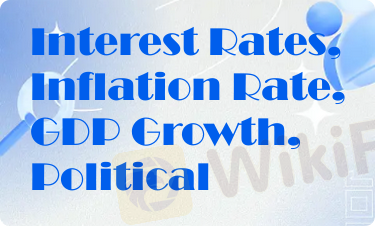
2025-02-12 04:24
IndustriyaTHE ROLE OF ECONOMIC INDICATORS IN FOREX TRENDS
#firstdealofthenewyearastylz
Economic indicators play a crucial role in shaping forex (foreign exchange) market trends, as they provide insights into a country's economic health and influence investor sentiment. Traders and investors use these indicators to predict currency movements and make informed trading decisions. Below are the key economic indicators and their impact on forex trends:
1. Interest Rates (Central Bank Policies)
Central banks (e.g., the Federal Reserve, European Central Bank) set interest rates, which directly impact currency values.
Higher interest rates attract foreign investment, increasing demand for the currency.
Lower interest rates lead to capital outflows, weakening the currency.
2. Inflation Rate (Consumer Price Index - CPI, Producer Price Index - PPI)
Moderate inflation is positive for a currency, signaling economic stability.
High inflation reduces purchasing power, weakening the currency.
Low inflation/deflation may indicate weak demand and economic slowdown, affecting forex markets negatively.
3. Gross Domestic Product (GDP) Growth
GDP measures overall economic output.
Strong GDP growth boosts currency value as it signals a robust economy.
Weak GDP growth can lead to currency depreciation due to reduced investor confidence.
4. Employment Data (Non-Farm Payrolls - NFP, Unemployment Rate)
A low unemployment rate signals economic strength, attracting investors and strengthening the currency.
A high unemployment rate suggests economic weakness, leading to currency depreciation.
The U.S. NFP report, released monthly, has a major impact on the forex market.
5. Trade Balance (Exports vs. Imports, Current Account)
A trade surplus (exports > imports) strengthens the domestic currency due to higher foreign demand.
A trade deficit (imports > exports) weakens the currency, as more local currency is sold to buy foreign goods.
6. Consumer & Business Confidence (PMI, Retail Sales, Consumer Sentiment)
Purchasing Managers’ Index (PMI): Measures business activity; a reading above 50 indicates economic expansion.
Retail Sales: Strong retail sales suggest consumer confidence and economic growth, supporting currency strength.
Consumer Confidence Index (CCI): Higher confidence boosts spending and currency value.
7. Political and Geopolitical Events
Elections, policy changes, and geopolitical tensions (e.g., wars, trade disputes) can cause forex volatility.
Political stability attracts foreign investment, strengthening the currency.
Uncertainty or crises lead to risk aversion, often strengthening safe-haven currencies like the U.S. dollar (USD), Swiss franc (CHF), and Japanese yen (JPY).
8. Market Sentiment and Speculation
Traders’ expectations based on upcoming data releases can influence forex trends.
Hawkish central bank signals (indicating rate hikes) strengthen a currency, while dovish signals (rate cuts) weaken it.
Katulad 0

General Solo
Mga brokers
Mainit na nilalaman
Pagsusuri ng merkado
Dogecoin cheers coinbase listing as Bitcoin’s range play continues
Pagsusuri ng merkado
Grayscale commits to converting GBTC into Bitcoin ETF:
Pagsusuri ng merkado
Bitcoin's price is not the only number going up
Pagsusuri ng merkado
Theta Price Prediction:
Pagsusuri ng merkado
How to Research Stocks:
Pagsusuri ng merkado
Bitcoin (BTC), Ethereum (ETH) Forecast:
Kategorya ng forum

Plataporma

Eksibisyon

Ahente

pangangalap

EA

Industriya

Merkado

talatuntunan
THE ROLE OF ECONOMIC INDICATORS IN FOREX TRENDS
 Hong Kong | 2025-02-12 04:24
Hong Kong | 2025-02-12 04:24#firstdealofthenewyearastylz
Economic indicators play a crucial role in shaping forex (foreign exchange) market trends, as they provide insights into a country's economic health and influence investor sentiment. Traders and investors use these indicators to predict currency movements and make informed trading decisions. Below are the key economic indicators and their impact on forex trends:
1. Interest Rates (Central Bank Policies)
Central banks (e.g., the Federal Reserve, European Central Bank) set interest rates, which directly impact currency values.
Higher interest rates attract foreign investment, increasing demand for the currency.
Lower interest rates lead to capital outflows, weakening the currency.
2. Inflation Rate (Consumer Price Index - CPI, Producer Price Index - PPI)
Moderate inflation is positive for a currency, signaling economic stability.
High inflation reduces purchasing power, weakening the currency.
Low inflation/deflation may indicate weak demand and economic slowdown, affecting forex markets negatively.
3. Gross Domestic Product (GDP) Growth
GDP measures overall economic output.
Strong GDP growth boosts currency value as it signals a robust economy.
Weak GDP growth can lead to currency depreciation due to reduced investor confidence.
4. Employment Data (Non-Farm Payrolls - NFP, Unemployment Rate)
A low unemployment rate signals economic strength, attracting investors and strengthening the currency.
A high unemployment rate suggests economic weakness, leading to currency depreciation.
The U.S. NFP report, released monthly, has a major impact on the forex market.
5. Trade Balance (Exports vs. Imports, Current Account)
A trade surplus (exports > imports) strengthens the domestic currency due to higher foreign demand.
A trade deficit (imports > exports) weakens the currency, as more local currency is sold to buy foreign goods.
6. Consumer & Business Confidence (PMI, Retail Sales, Consumer Sentiment)
Purchasing Managers’ Index (PMI): Measures business activity; a reading above 50 indicates economic expansion.
Retail Sales: Strong retail sales suggest consumer confidence and economic growth, supporting currency strength.
Consumer Confidence Index (CCI): Higher confidence boosts spending and currency value.
7. Political and Geopolitical Events
Elections, policy changes, and geopolitical tensions (e.g., wars, trade disputes) can cause forex volatility.
Political stability attracts foreign investment, strengthening the currency.
Uncertainty or crises lead to risk aversion, often strengthening safe-haven currencies like the U.S. dollar (USD), Swiss franc (CHF), and Japanese yen (JPY).
8. Market Sentiment and Speculation
Traders’ expectations based on upcoming data releases can influence forex trends.
Hawkish central bank signals (indicating rate hikes) strengthen a currency, while dovish signals (rate cuts) weaken it.
Katulad 0
Gusto kong magkomento din
Ipasa
0Mga komento

Wala pang komento. Gawin ang una.

Ipasa
Wala pang komento. Gawin ang una.